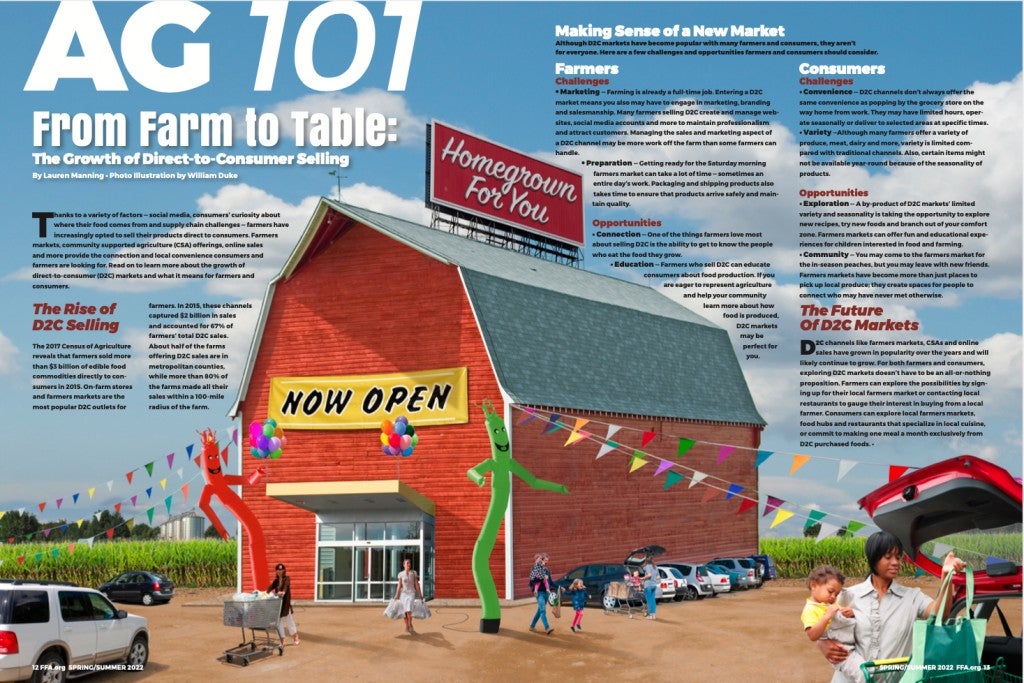
Thanks to a variety of factors — social media, consumers’ curiosity about where their food comes from and supply chain challenges — farmers have increasingly opted to sell their products direct to consumers. Farmers markets, community supported agriculture (CSA) offerings, online sales and more provide the connection and local convenience consumers and farmers are looking for. Read on to learn more about the growth of direct-to-consumer (D2C) markets and what it means for farmers and consumers.
The Rise of D2C Selling
The 2017 Census of Agriculture reveals that farmers sold more than $3 billion of edible food commodities directly to consumers in 2015. On-farm stores and farmers markets are the most popular D2C outlets for farmers. In 2015, these channels captured $2 billion in sales and accounted for 67% of farmers’ total D2C sales. About half of the farms offering D2C sales are in metropolitan counties, while more than 80% of the farms made all their sales within a 100-mile radius of the farm.
Making Sense of a New Market
Although D2C markets have become popular with many farmers and consumers, they aren’t for everyone. Here are a few challenges and opportunities farmers and consumers should consider.
Farmers
Challenges
- Marketing — Farming is already a full-time job. Entering a D2C market means you also may have to engage in marketing, branding and salesmanship. Many farmers selling D2C create and manage websites, social media accounts and more to maintain professionalism and attract customers. Managing the sales and marketing aspect of a D2C channel may be more work off the farm than some farmers can handle.
- Preparation — Getting ready for the Saturday morning farmers market can take a lot of time — sometimes an entire day’s work. Packaging and shipping products also takes time to ensure that products arrive safely and maintain quality.
Opportunities
- Connection — One of the things farmers love most about selling D2C is the ability to get to know the people who eat the food they grow.
- Education — Farmers who sell D2C can educate consumers about food production. If you are eager to represent agriculture and help your community learn more about how food is produced, D2C markets may be perfect for you.
Consumers
Challenges
- Convenience — D2C channels don’t always offer the same convenience as popping by the grocery store on the way home from work. They may have limited hours, operate seasonally or deliver to selected areas at specific times.
- Variety —Although many farmers offer a variety of produce, meat, dairy and more, variety is limited compared with traditional channels. Also, certain items might not be available year-round because of the seasonality of products.
Opportunities
- Exploration — A by-product of D2C markets’ limited variety and seasonality is taking the opportunity to explore new recipes, try new foods and branch out of your comfort zone. Farmers markets can offer fun and educational experiences for children interested in food and farming.
- Community — You may come to the farmers market for the in-season peaches, but you may leave with new friends. Farmers markets have become more than just places to pick up local produce; they create spaces for people to connect who may have never met otherwise.
The Future Of D2C Markets
D2C channels like farmers markets, CSAs and online sales have grown in popularity over the years and will likely continue to grow. For both farmers and consumers, exploring D2C markets doesn’t have to be an all-or-nothing proposition. Farmers can explore the possibilities by signing up for their local farmers market or contacting local restaurants to gauge their interest in buying from a local farmer. Consumers can explore local farmers markets, food hubs and restaurants that specialize in local cuisine, or commit to making one meal a month exclusively from D2C purchased foods.











